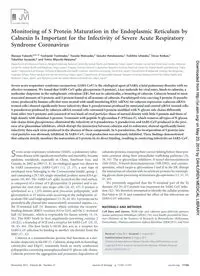
2012 Monitoring of S Protein Maturation in the Endoplasmic Reticulum by Calnexin Is Important for the Infectivity of Sev PDF
Preview 2012 Monitoring of S Protein Maturation in the Endoplasmic Reticulum by Calnexin Is Important for the Infectivity of Sev
Monitoring of S Protein Maturation in the Endoplasmic Reticulum by Calnexin Is Important for the Infectivity of Severe Acute Respiratory Syndrome Coronavirus Masaya Fukushi,a,b,c,d Yoshiyuki Yoshinaka,e Yusuke Matsuoka,a Seisuke Hatakeyama,a Yukihito Ishizaka,f Teruo Kirikae,a Takehiko Sasazuki,g and Tohru Miyoshi-Akiyamaa Department of Infectious Diseases, Research Institute, National Center for Global Health and Medicine, Tokyo, Japana; Disease Control and Prevention Center, National Center for Global Health and Medicine, Tokyo, Japanb; Deputy Director-General’s Laboratory, Research Institute, National Center for Global Health and Medicine, Tokyo, Japanc; Department of Virology, Institute of Biomedical & Health Sciences, Hiroshima University, Hiroshima, Japand; Department of Molecular Virology, Bio-Response, Graduate School, Tokyo Medical and Dental University, Tokyo, Japane; Department of Intractable Diseases, Research Institute, National Center for Global Health and Medicine, Tokyo, Japanf; and National Center for Global Health and Medicine, Tokyo, Japang Severe acute respiratory syndrome coronavirus (SARS-CoV) is the etiological agent of SARS, a fatal pulmonary disorder with no effective treatment. We found that SARS-CoV spike glycoprotein (S protein), a key molecule for viral entry, binds to calnexin, a molecular chaperone in the endoplasmic reticulum (ER), but not to calreticulin, a homolog of calnexin. Calnexin bound to most truncated mutants of S protein, and S protein bound to all mutants of calnexin. Pseudotyped virus carrying S protein (S-pseudo- virus) produced by human cells that were treated with small interfering RNA (siRNA) for calnexin expression (calnexin siRNA- treated cells) showed significantly lower infectivity than S-pseudoviruses produced by untreated and control siRNA-treated cells. S-pseudovirus produced by calnexin siRNA-treated cells contained S protein modified with N-glycan side chains differently from other two S proteins and consisted of two kinds of viral particles: those of normal density with little S protein and those of high density with abundant S protein. Treatment with peptide-N-glycosidase F (PNGase F), which removes all types of N-glycan side chains from glycoproteins, eliminated the infectivity of S-pseudovirus. S-pseudovirus and SARS-CoV produced in the pres- ence of �-glucosidase inhibitors, which disrupt the interaction between calnexin and its substrates, showed significantly lower infectivity than each virus produced in the absence of those compounds. In S-pseudovirus, the incorporation of S protein into viral particles was obviously inhibited. In SARS-CoV, viral production was obviously inhibited. These findings demonstrated that calnexin strictly monitors the maturation of S protein by its direct binding, resulting in conferring infectivity on SARS-CoV. S evere acute respiratory syndrome (SARS), a pulmonary infec- tious disease with significant morbidity and mortality, became epidemic worldwide, especially in China, Southeast Asia, and Canada, in 2002 to 2003 (5, 8). Its etiological agent was shown to be SARS coronavirus (SARS-CoV) (11, 23, 37), a new type of enveloped virus belonging to the Coronaviridae family, group 2, and containing a 29.7-kb, single-stranded, positive-sense RNA ge- nome (30, 40). The SARS-CoV spike, located on the viral surface, is composed of a trimer of S glycoprotein (S protein) and is im- portant for viral entry into target cells (28, 43, 47). S protein is synthesized as a 1,255-amino-acid precursor polypeptide, with glycosylation at 23 amino acids occurring in the endoplasmic re- ticulum (ER) and Golgi apparatus (13, 30, 40, 46). S protein can be proteolytically cleaved into noncovalently associated regions, i.e., the N-terminal half (S1 domain), which contains the receptor- binding domain (RBD) (residues 318 to 510), and the C-terminal half (S2 domain), which is responsible for fusion activity (3, 14, 26). The RBD binds to host angiotensin-converting enzyme 2 (ACE2), a homolog of ACE and a receptor for SARS-CoV (24, 27, 38, 45, 46). The host lectin L-SIGN also acts as a receptor for SARS-CoV infection by binding to another site distinct from the RBD (17, 22). Calnexin is a transmembrane protein that functions as a mo- lecular chaperone in the ER (2). Calnexin, along with its homologs calreticulin and ERp57, transiently binds to newly synthesized polypeptides containing monoglucosylated N-glycan side chains. Calnexin prevents the aggregation and premature degradation of substrate proteins, ensuring their correct folding before these pro- teins continue along their intracellular trafficking pathways (16, 20, 34). The �-glycosidase inhibitors N-nonyl-deoxynojirimycin (NN-DNJ), N-butyl-deoxynojirimycin (NB-DNJ), and castano- spermine, which target �-glycosidases I and II in the ER, disrupt the interaction of calnexin with its substrate proteins by interrupt- ing glycan chain processing of immature glycoproteins (12, 31, 35, 41, 49). We previously suggested that the N-terminal part of the S2 domain (S2-N) of S protein was important for SARS-CoV infec- tion (42). We therefore attempted to identify the cellular proteins that bind to S2-N and examined the effect of this interaction on SARS-CoV infection. MATERIALS AND METHODS Cell lines and viruses. Wild-type and calnexin gene-deficient primary mouse embryonic fibroblasts (MEFs) (10) were kindly provided by Mau- rizio Molinari of the Institute of Research in Biomedicine (Bellinzona, Switzerland). Human embryonic kidney fibroblast (HEK293T) and Vero Received 18 May 2012 Accepted 12 August 2012 Published ahead of print 22 August 2012 Address correspondence to Masaya Fukushi,
